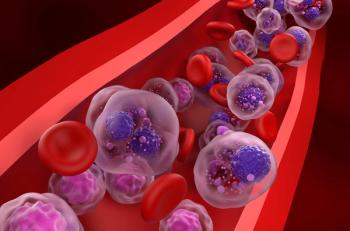
- June 2020
- Volume 3
- Issue 2
JAK Inhibitors Are Important Tools for Patients With Myelofibrosis
This cancer is characterized by scar tissue accumulation in the bone marrow, which leads to an insufficient quantity of normal blood cells.
IN ONE VIRTUAL symposium held in conjunction with the Asembia Specialty Pharmacy Summit, speakers delved into the rare cancer myelofibrosis. This cancer is characterized by scar tissue accumulation in the bone marrow, which leads to an insufficient quantity of normal blood cells. This deficiency in normal cells eventually precipitates the signs and symptoms of primary myelofibrosis.
At first, most people who have this disease will be asymptomatic; but with time, the shortage of red and white blood cells and platelets leads to anemia, fatigue, and, often, shortness of breath. Simultaneously, patients have an increased risk of contracting infections and may bruise or bleed easily. In an attempt to compensate, other organs (eg, spleen, liver) may begin to produce blood cells. This extramedullary hematopoiesis can cause splenomegaly or hepatomegaly, usually presenting as pain or abdominal fullness. Patients also often report fever, weight loss, and night sweats, as well as early satiety.
Julianne Darling, PharmD, BCOP, BCPS, expanded on the basic molecular distinctions of myelofibrosis. Scientists have tracked these mutations to specific gene locations, with the 3 predominant mutations being the JAK2, MPL, and CALR aberrations.
She also reviewed treatment goals, indicating that clinicians need to complete a risk/benefit analysis of treatment strategies for patients. Reduction of spleen size and clotting risk, control of symptoms, and alleviation of anemia are critical to (hopefully) increasing overall survival. Guideline-directed therapy includes stem cell transplant, traditional cytotoxic chemotherapy, and treatment for anemia.
The JAK inhibitors are currently a treatment cornerstone, having largely replaced traditional chemotherapy. Ruxolitinib is FDA approved for intermediate-risk or high-risk myelofibrosis, with the evidence for efficacy and safety coming from two phase 3 studies, COMFORT I (NCT00952289) and COMFORT II (NCT00934544). Fedratinib is also FDA approved for intermediate- to high-risk primary or secondary myelofibrosis. Evidence for use of this medication came from the JAKARTA trial. Several other JAK inhibitors are currently in clinical trials, and Darling reviewed those closest to approval.
Jeff Reichard, PharmD, MS, BCOP, started by summarizing key factors related to the treatment of myelofibrosis and how they affect medications that are available only through specialty pharmacy channels. The 3 major stakeholders—–manufacturers, payers and pharmacy providers––have different considerations with some overlap. He explained that manufacturers examine medication distribution nuances, pharmacy care coordination, outcomes reporting, and patient assistance programs and financial support. Payer considerations include formulary tier structures, therapy escalation strategies, drug-class management, outcomes reporting, and the specifics of the disease for which the medication has been developed. The pharmacy providers’ concerns include care coordination, formulary considerations, the purchasing channel employed, the patient’s treatment goals, and, again, financial assistance for patients.
Reichard also discussed some of the economic implications of myelofibrosis, including direct and indirect costs of care. The health care team needs to consider the quality-of-life implications when selecting treatments. For this reason, it is critical for health systems to risk stratify patients, create treatment protocols, and watch the progression of medications through the pipeline. Reichard stressed that it is important to understand patient treatment goals and involve patients in treatment planning. He concluded by discussing the role of the pharmacy care team within the larger multidisciplinary care team and suggesting interventions that may help optimize patient outcomes.
Articles in this issue
over 5 years ago
CIDP Care: A Patient and Clinical Experts Weigh Inover 5 years ago
The Multidisciplinary Team Improves Cystic Fibrosis OutcomesNewsletter
Stay informed on drug updates, treatment guidelines, and pharmacy practice trends—subscribe to Pharmacy Times for weekly clinical insights.













































































































































































































